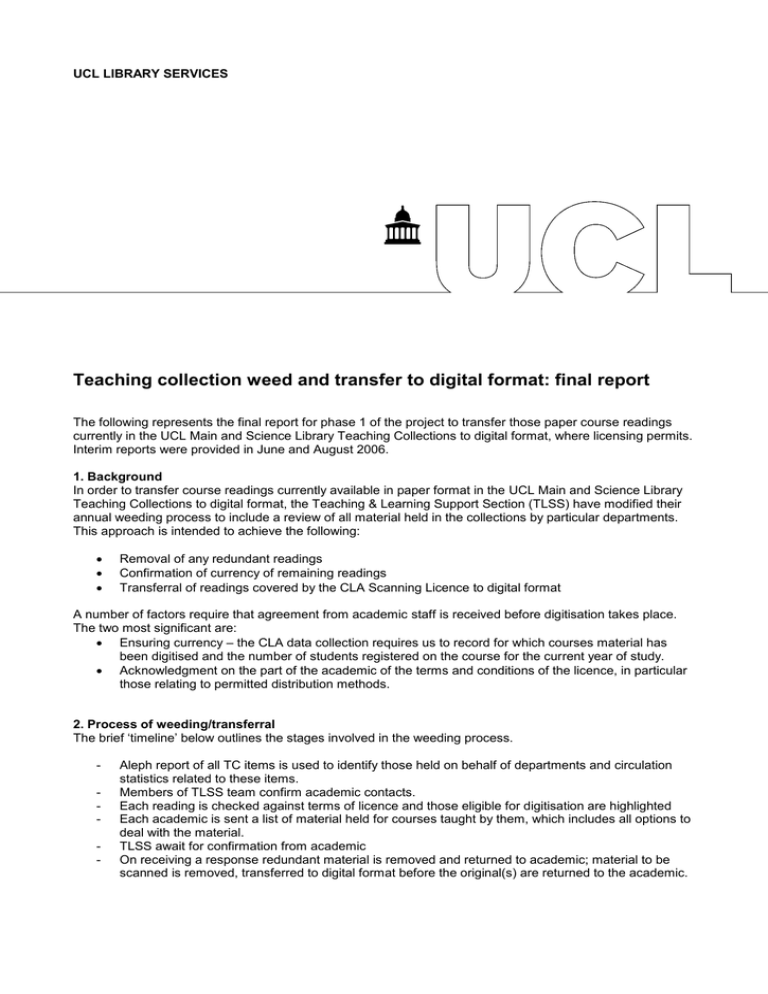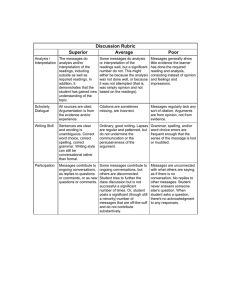Teaching collection weed and transfer to digital format: final report
advertisement

UCL LIBRARY SERVICES Teaching collection weed and transfer to digital format: final report The following represents the final report for phase 1 of the project to transfer those paper course readings currently in the UCL Main and Science Library Teaching Collections to digital format, where licensing permits. Interim reports were provided in June and August 2006. 1. Background In order to transfer course readings currently available in paper format in the UCL Main and Science Library Teaching Collections to digital format, the Teaching & Learning Support Section (TLSS) have modified their annual weeding process to include a review of all material held in the collections by particular departments. This approach is intended to achieve the following: Removal of any redundant readings Confirmation of currency of remaining readings Transferral of readings covered by the CLA Scanning Licence to digital format A number of factors require that agreement from academic staff is received before digitisation takes place. The two most significant are: Ensuring currency – the CLA data collection requires us to record for which courses material has been digitised and the number of students registered on the course for the current year of study. Acknowledgment on the part of the academic of the terms and conditions of the licence, in particular those relating to permitted distribution methods. 2. Process of weeding/transferral The brief ‘timeline’ below outlines the stages involved in the weeding process. - Aleph report of all TC items is used to identify those held on behalf of departments and circulation statistics related to these items. Members of TLSS team confirm academic contacts. Each reading is checked against terms of licence and those eligible for digitisation are highlighted Each academic is sent a list of material held for courses taught by them, which includes all options to deal with the material. TLSS await for confirmation from academic On receiving a response redundant material is removed and returned to academic; material to be scanned is removed, transferred to digital format before the original(s) are returned to the academic. - Finally, if no response is received by July 16th paper material will be removed from the collections and returned to academics. 3. Weeding statistics Phase 1 of the project has focussed on the bigger users of the existing paper collections. The following departments have been contacted as part of the project: Anthropology English History History of Art Laws Political Science Overall figures: Number of academics contacted Number of courses involved Number of courses for which replies were received Number of items removed Total number of items digitised 63 116 79 959 catalogue entries and 1181 additional copies = 2140 items in total 466 Breakdown by department Anthropology: Lecturers contacted No. of courses involved No. of courses for which replies were received No. of items (multiple copies) removed No. of items scanned 9 10 10 155 (454) 104 English: Lecturers contacted No. of courses involved No. of courses for which replies were received No. of items (multiple copies) removed No. of items scanned 2 2 2 19 (11) 6 History: Lecturers contacted No. of courses involved No. of courses for which replies were received No. of items (multiple copies) removed No. of items scanned 20 47 33 387 (386) 233 History of Art: Lecturers contacted No. of courses involved No. of courses for which replies were received No. of items (multiple copies) removed No. of items scanned 15 30 23 222 (178) 90 Laws: Lecturers contacted No. of courses involved No. of courses for which replies were received No. of items (multiple copies) removed No. of items scanned 11 16 9 129 (137) 18 Political Science*: Lecturers contacted 6 No. of courses involved 11 No. of courses for which replies were received 2 No. of items (multiple copies) removed 47 (15) No. of items scanned 15 * Figures for Political Science are low as they have already worked with TLSS to create digital readings for many of their taught courses. 4. The Future? In line with UCL Library Services’ strategic plan, work to transfer as much of the remaining paper collection as possible to digital format is set to continue. Below is a plan to extend the service, which takes into consideration possible developments in licensing: Action Phase 2 of TC project: All existing eligible UK published paper readings to be converted to digital format or removed as redundant Phase 3: Identify all current non-UK published paper readings (lecturers to confirm that material needed). All non-current material to be removed. CLA Trial Scanning Licence to be renegotiated; possible reciprocal agreements with non-UK publishers Timeframe September 2007 October 2007-July 2008 Summer 2008 While the eventual goal is to create an entirely digital course reading environment, which exploits the Electronic Library collections available to UCL – bringing together e-journals, e-books and readings scanned under licence – the evolution of this service is subject to developments in current licensing. The most significant factor influencing the service will be the CLA Licence renegotiation in Summer 2008. It has been suggested that the CLA will move to negotiate reciprocal agreements with other countries, most importantly the USA, in order to extend the scope of the licence. However, it is important not to assume this extension will happen, so plans for a sustainable service that extends beyond provision possible under the current licence are also important. A number of factors will inform how this service is developed: A. Funding Recurrent costs: any material not covered by a blanket licence will need transactional permission clearance. This will almost always incur a fee. The fee is typically paid on a per page/per student rate. Licences are granted for one year only, so the fee will need to be re-paid each year for as long as the material is used. How much funding is required? Phase 3 (above) is key to identifying what the likely cost of paying for transactional clearances might be. However, this will give an indication only of what it would cost to digitise the existing collection. Funding will have to incorporate the extension of the service to new courses. Without any costings in place it is extremely difficult to estimate a figure. Based on other institutions (LSE) that have received central funding, a sum of £40K would be a guess at an appropriate figure to enable the licensing of existing readings, and extension of the service. (See recommendations below) Allocation of funds: considerable thought will need to be given to how funding is allocated whether limits (e.g. on the no. of readings per course, on the maximum permission fee UCL is willing to pay) will need to be set. It is worth bearing in mind, that not all publishers in the UK or elsewhere participate in blanket licensing schemes, and they are under no obligation to do so. Some material will always attract permission fees and a small amount of ‘contingency’ funding would be advisable. B. Electronic course materials and collection development An evaluation which considers how the electronic resources available – e-journals/e-books, digitised readings, digital images, etc – can be best exploited to deliver taught course support needs to be carried out. (See recommendations below) 5. Recommendations: Transfer remaining eligible paper readings to digital format Identify all current non-UK paper readings Gather sample permission costs to inform any potential funding bid Undertake an evaluation: to compare the relative costs of licensing commercially produced resources, vs. creating and maintaining digital copies to consider how the results might inform collection development policies regarding taught course support June Hedges Nov 2006



